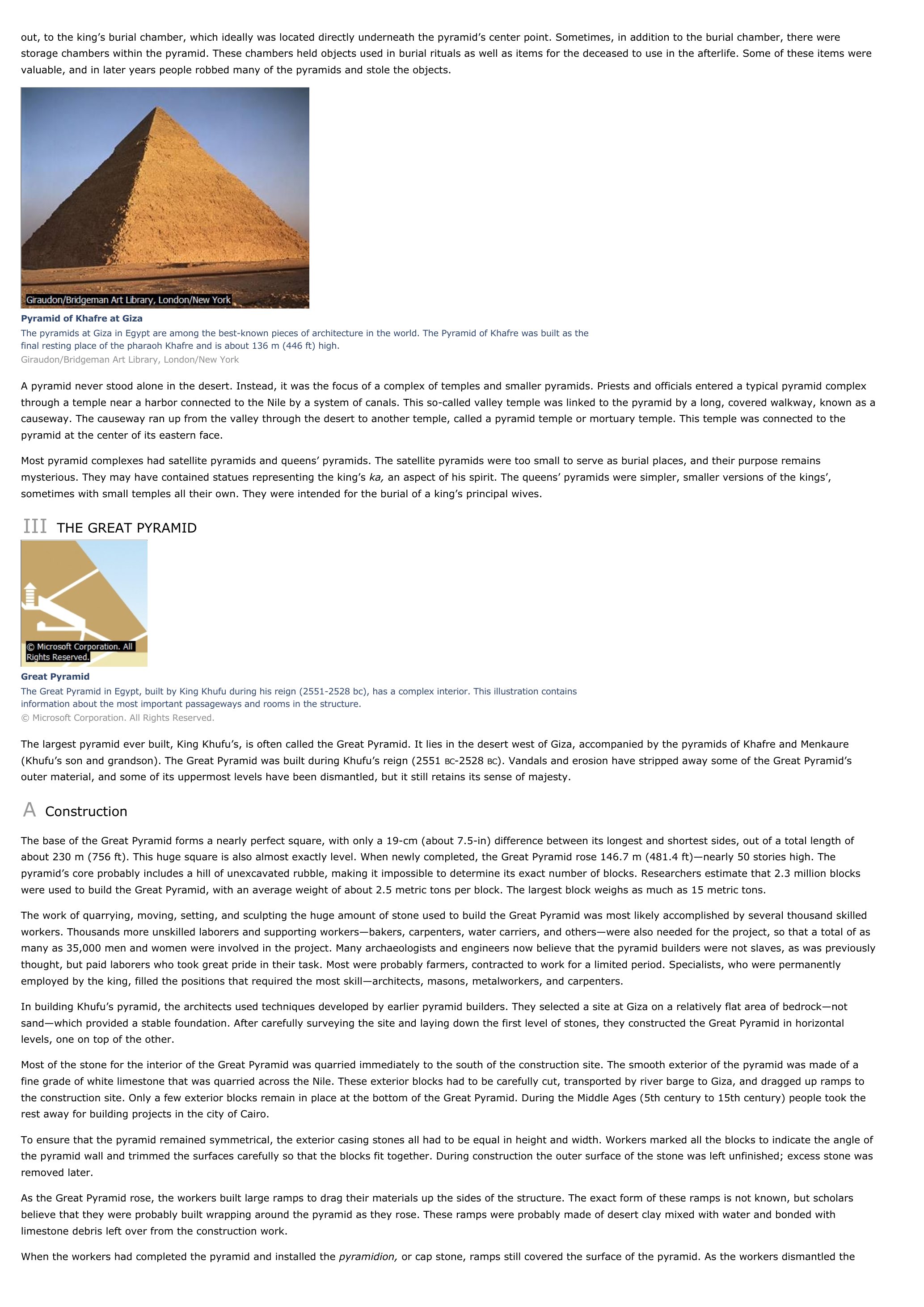Pyramids (Egypt) - history.
Publié le 26/05/2013
Extrait du document
«
out, to the king’s burial chamber, which ideally was located directly underneath the pyramid’s center point.
Sometimes, in addition to the burial chamber, there werestorage chambers within the pyramid.
These chambers held objects used in burial rituals as well as items for the deceased to use in the afterlife.
Some of these items werevaluable, and in later years people robbed many of the pyramids and stole the objects.
Pyramid of Khafre at GizaThe pyramids at Giza in Egypt are among the best-known pieces of architecture in the world.
The Pyramid of Khafre was built as thefinal resting place of the pharaoh Khafre and is about 136 m (446 ft) high.Giraudon/Bridgeman Art Library, London/New York
A pyramid never stood alone in the desert.
Instead, it was the focus of a complex of temples and smaller pyramids.
Priests and officials entered a typical pyramid complexthrough a temple near a harbor connected to the Nile by a system of canals.
This so-called valley temple was linked to the pyramid by a long, covered walkway, known as acauseway.
The causeway ran up from the valley through the desert to another temple, called a pyramid temple or mortuary temple.
This temple was connected to thepyramid at the center of its eastern face.
Most pyramid complexes had satellite pyramids and queens’ pyramids.
The satellite pyramids were too small to serve as burial places, and their purpose remainsmysterious.
They may have contained statues representing the king’s ka, an aspect of his spirit.
The queens’ pyramids were simpler, smaller versions of the kings’, sometimes with small temples all their own.
They were intended for the burial of a king’s principal wives.
III THE GREAT PYRAMID
Great PyramidThe Great Pyramid in Egypt, built by King Khufu during his reign (2551-2528 bc), has a complex interior.
This illustration containsinformation about the most important passageways and rooms in the structure.© Microsoft Corporation.
All Rights Reserved.
The largest pyramid ever built, King Khufu’s, is often called the Great Pyramid.
It lies in the desert west of Giza, accompanied by the pyramids of Khafre and Menkaure(Khufu’s son and grandson).
The Great Pyramid was built during Khufu’s reign (2551 BC-2528 BC).
Vandals and erosion have stripped away some of the Great Pyramid’s outer material, and some of its uppermost levels have been dismantled, but it still retains its sense of majesty.
A Construction
The base of the Great Pyramid forms a nearly perfect square, with only a 19-cm (about 7.5-in) difference between its longest and shortest sides, out of a total length ofabout 230 m (756 ft).
This huge square is also almost exactly level.
When newly completed, the Great Pyramid rose 146.7 m (481.4 ft)—nearly 50 stories high.
Thepyramid’s core probably includes a hill of unexcavated rubble, making it impossible to determine its exact number of blocks.
Researchers estimate that 2.3 million blockswere used to build the Great Pyramid, with an average weight of about 2.5 metric tons per block.
The largest block weighs as much as 15 metric tons.
The work of quarrying, moving, setting, and sculpting the huge amount of stone used to build the Great Pyramid was most likely accomplished by several thousand skilledworkers.
Thousands more unskilled laborers and supporting workers—bakers, carpenters, water carriers, and others—were also needed for the project, so that a total of asmany as 35,000 men and women were involved in the project.
Many archaeologists and engineers now believe that the pyramid builders were not slaves, as was previouslythought, but paid laborers who took great pride in their task.
Most were probably farmers, contracted to work for a limited period.
Specialists, who were permanentlyemployed by the king, filled the positions that required the most skill—architects, masons, metalworkers, and carpenters.
In building Khufu’s pyramid, the architects used techniques developed by earlier pyramid builders.
They selected a site at Giza on a relatively flat area of bedrock—notsand—which provided a stable foundation.
After carefully surveying the site and laying down the first level of stones, they constructed the Great Pyramid in horizontallevels, one on top of the other.
Most of the stone for the interior of the Great Pyramid was quarried immediately to the south of the construction site.
The smooth exterior of the pyramid was made of afine grade of white limestone that was quarried across the Nile.
These exterior blocks had to be carefully cut, transported by river barge to Giza, and dragged up ramps tothe construction site.
Only a few exterior blocks remain in place at the bottom of the Great Pyramid.
During the Middle Ages (5th century to 15th century) people took therest away for building projects in the city of Cairo.
To ensure that the pyramid remained symmetrical, the exterior casing stones all had to be equal in height and width.
Workers marked all the blocks to indicate the angle ofthe pyramid wall and trimmed the surfaces carefully so that the blocks fit together.
During construction the outer surface of the stone was left unfinished; excess stone wasremoved later.
As the Great Pyramid rose, the workers built large ramps to drag their materials up the sides of the structure.
The exact form of these ramps is not known, but scholarsbelieve that they were probably built wrapping around the pyramid as they rose.
These ramps were probably made of desert clay mixed with water and bonded withlimestone debris left over from the construction work.
When the workers had completed the pyramid and installed the pyramidion, or cap stone, ramps still covered the surface of the pyramid.
As the workers dismantled the.
»
↓↓↓ APERÇU DU DOCUMENT ↓↓↓
Liens utiles
- Pyramids (Egypt) - History.
- Ancient Egypt - history.
- Pyramids (Egypt) - geography.
- Ancient Egypt - USA History.
- Pyramids (Egypt) - geography.






